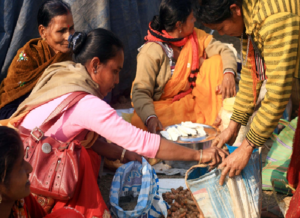In an era where going cashless is the trend, Jonbeel mela serves as a veritable blast from the past. Gaining its name from the Assamese words ‘Jon’ meaning moon and ‘beel’ meaning wetland due to the crescent shaped wetland near which the fair is held, Jonbeel mela is the only market in India now where barter system is still prevalent. Starting in the 15th century, the Ahom kings of Assam held it as a political conference where people from both the plains and hills came to share their issues with the monarch. It is the place where the hill tribes come down to exchange their native growth with the ones that are usually found in the plains. This exchange usually involves spices herbs, fruits and ginger from the hills and fish, rice and pithas (Assamese delicacies usually made of rice) from the plains. Thus it is celebrated in the weekend following the harvest festival, Magh Bihu, that is celebrated in the mid of January.
Presently, the fair is organized by the Tiwa community in Dayang Belguri 30km away from Guwahati. The fair sees participation from all the traditional communities that have provided their patronage over centuries. This includes the Tiwa, Khasis, Jaitia and Karbi communities that descent from the hills of both Assam and Meghalaya. They all have their own language and culture but this fair promotes the harmony and brotherhood prevailing amongst them.
The 3 days event starts with an Agni puja praying for the well being of all mankind followed by the trade on the second day. The market does not only forgo the use of currency but also the use of weights and measures. It mostly runs on the measurement of hands and cups and the parties involved in a purchase bargain to a deal which they both find satisfactory. The hill tribes and others who have travelled far live in makeshift bamboo huts near the wetland during this duration and the atmosphere is filled with merry making as they perform their folk songs and dance. It also includes sports like cock fighting and community fishing in the Jonbeel.
About thousands of tribesmen travel far every year to participate in the fair resulting in transactions worth crores of rupees. But the economy is not the only benefit of the fair. It now promotes harmony and brotherhood amongst the different tribes separated by geography. They live together, eat together, enjoy together. Everyone in the market refers to each other as ‘mama’ and ‘mami’ (maternal uncle and aunt).
The Gobha Roja or the head of the tribes oversees the fair. In medieval times he was the King of the tribes in the area who organized the fair. Now their descendents don’t hold the same political power though they still hold the respect in the hearts of their tribesmen. During the mela, the Gobha Roja visits the ground of the mela and enjoys a community feast with his subjects followed by a ‘durbar’ on the last day where he listens to the grievances of the commoners and his courtiers collect taxes from them. This does not hold much significance today rather it is a salute to the age old tradition.
Though the whole concept of the fair has survived through centuries it has learned to adapt with the age as well. Alongside the traditional harvest, wild growth, home-made delicacies and handmade artifacts, now one can also find fast food or packeted food and factory made artifacts. And to add on to the entertainment, cock fight is now accompanied by various other choices like Ferris wheel and the well of death for motorcycle stunts. The air now not only echoes of the traditional tunes but also of Bollywood songs and so on.
The changes are inevitable but Jonbeel mela is undoubtedly a living, breathing historical example of market and trade with the bonus of serving as a chance for fraternizing amongst the different communities.








One Response
Informative read.